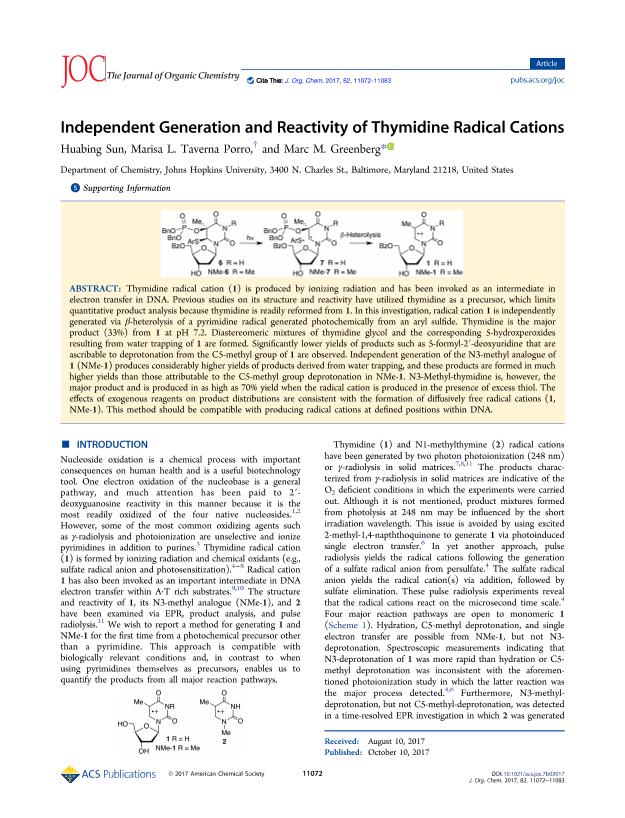Mostrar el registro sencillo del ítem
dc.contributor.author
Sun, Huabing
dc.contributor.author
Taverna Porro, Marisa Lia

dc.contributor.author
Greenberg, Marc M.
dc.date.available
2018-06-06T20:32:58Z
dc.date.issued
2017-10
dc.identifier.citation
Sun, Huabing; Taverna Porro, Marisa Lia; Greenberg, Marc M.; Independent Generation and Reactivity of Thymidine Radical Cations; American Chemical Society; Journal of Organic Chemistry; 82; 20; 10-2017; 11072-11083
dc.identifier.issn
0022-3263
dc.identifier.uri
http://hdl.handle.net/11336/47605
dc.description.abstract
Thymidine radical cation (1) is produced by ionizing radiation and has been invoked as an intermediate in electron transfer in DNA. Previous studies on its structure and reactivity have utilized thymidine as a precursor, which limits quantitative product analysis because thymidine is readily reformed from 1. In this investigation, radical cation 1 is independently generated via β-heterolysis of a pyrimidine radical generated photochemically from an aryl sulfide. Thymidine is the major product (33%) from 1 at pH 7.2. Diastereomeric mixtures of thymidine glycol and the corresponding 5-hydroxperoxides resulting from water trapping of 1 are formed. Significantly lower yields of products such as 5-formyl-2′-deoxyuridine that are ascribable to deprotonation from the C5-methyl group of 1 are observed. Independent generation of the N3-methyl analogue of 1 (NMe-1) produces considerably higher yields of products derived from water trapping, and these products are formed in much higher yields than those attributable to the C5-methyl group deprotonation in NMe-1. N3-Methyl-thymidine is, however, the major product and is produced in as high as 70% yield when the radical cation is produced in the presence of excess thiol. The effects of exogenous reagents on product distributions are consistent with the formation of diffusively free radical cations (1, NMe-1). This method should be compatible with producing radical cations at defined positions within DNA.
dc.format
application/pdf
dc.language.iso
eng
dc.publisher
American Chemical Society

dc.rights
info:eu-repo/semantics/openAccess
dc.rights.uri
https://creativecommons.org/licenses/by-nc-sa/2.5/ar/
dc.subject
Radical Cation
dc.subject
Dna Lesions
dc.subject
Irradiation
dc.subject.classification
Otras Ciencias Químicas

dc.subject.classification
Ciencias Químicas

dc.subject.classification
CIENCIAS NATURALES Y EXACTAS

dc.title
Independent Generation and Reactivity of Thymidine Radical Cations
dc.type
info:eu-repo/semantics/article
dc.type
info:ar-repo/semantics/artículo
dc.type
info:eu-repo/semantics/publishedVersion
dc.date.updated
2018-06-06T19:44:14Z
dc.journal.volume
82
dc.journal.number
20
dc.journal.pagination
11072-11083
dc.journal.pais
Estados Unidos

dc.description.fil
Fil: Sun, Huabing. University Johns Hopkins; Estados Unidos
dc.description.fil
Fil: Taverna Porro, Marisa Lia. University Johns Hopkins; Estados Unidos. Consejo Nacional de Investigaciones Científicas y Técnicas; Argentina
dc.description.fil
Fil: Greenberg, Marc M.. University Johns Hopkins; Estados Unidos
dc.journal.title
Journal of Organic Chemistry

dc.relation.alternativeid
info:eu-repo/semantics/altIdentifier/doi/https://dx.doi.org/10.1021/acs.joc.7b02017
dc.relation.alternativeid
info:eu-repo/semantics/altIdentifier/url/https://pubs.acs.org/doi/10.1021/acs.joc.7b02017
Archivos asociados
